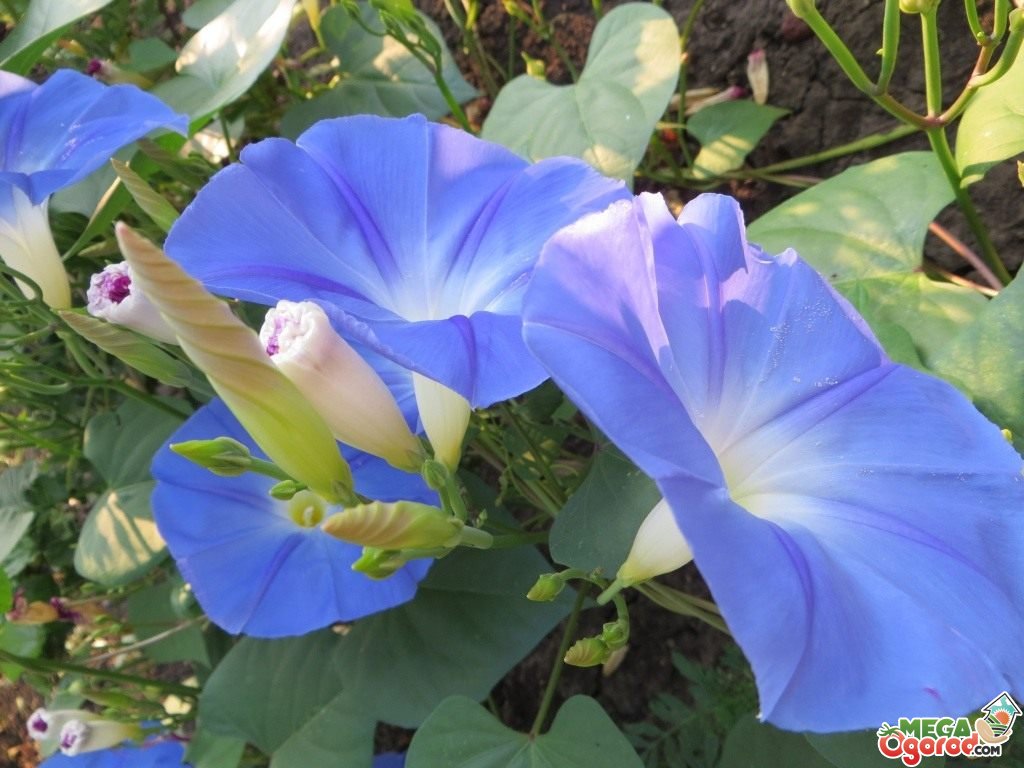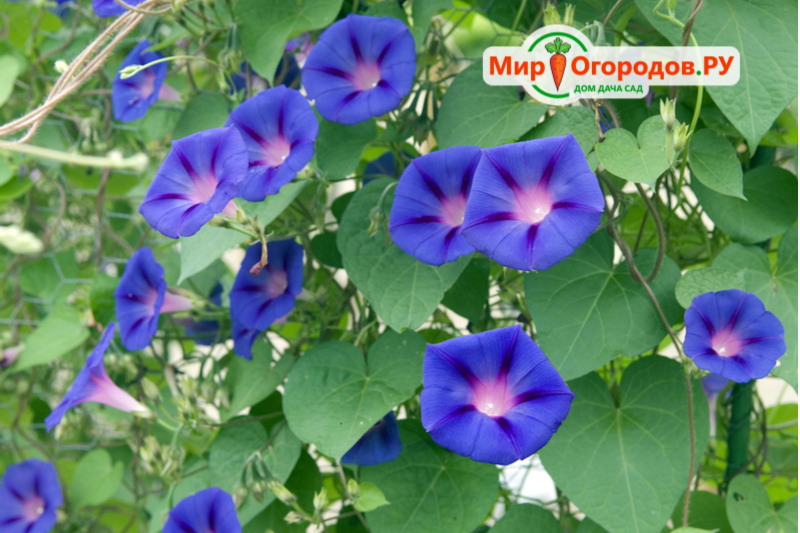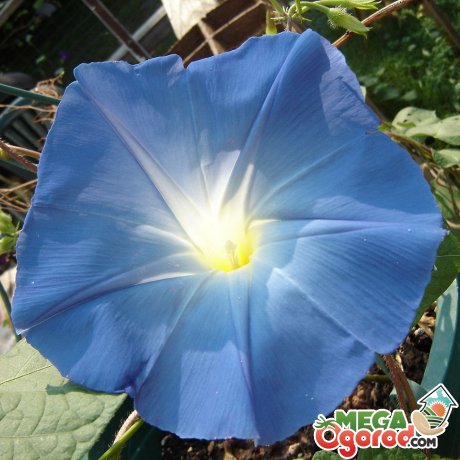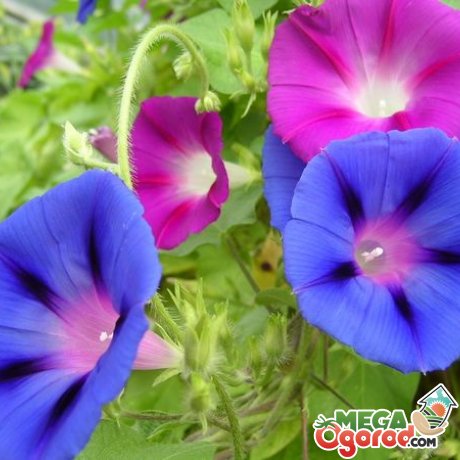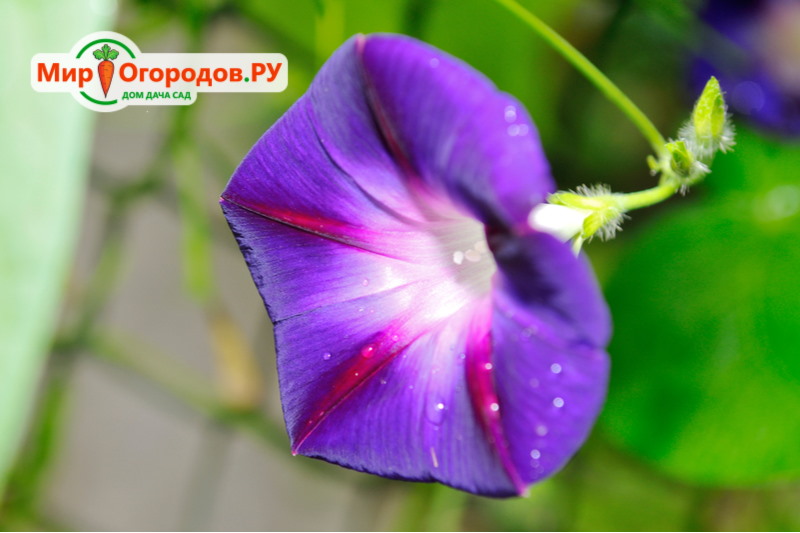Varieties and types of morning glory with description and photos
Out of half a thousand species, only 25 are cultivated.
The most common:
Morning glory Ipomoea cairica

Ipomoea cairo Ipomoea cairica photo
A native of Australia, Asia, it is distinguished by thick bright blue flowers, the length of the lash is up to 5 meters. A perennial liana, densely wrapping around the support, covering everything with a continuous carpet of thick leaves with flowers scattered over it. Luxurious decoration of glazed loggias, spacious rooms, terraces. Belongs to the sweet potato genus.
Ipomoea purpurea Ipomoea purpurea

Ipomoea purpurea Ipomoea purpurea photo
An annual reaching 8 meters with single multi-colored flowers - there are varieties with white, pink, blue, lilac, purple hues, flowers can be double.
Ipomoea nil Ipomoea nil

Morning glory nile cultivar Ipomoea nil ‘Good Morning Violet’ photo
Annual up to 3 meters, large leaves, flowers are dark blue, pink, purple, red with a white edging about 10 cm in diameter.
Ipomoea tricolor Ipomoea tricolor

Ipomoea tricolor Ipomoea tricolor photo
Liana up to 5 meters long, flowers of a sky-blue hue are collected in inflorescences up to four pieces.
Ipomoea ivy Ipomoea hederacea

Ipomoea ivy Ipomoea hederacea photo
American liana up to 3 meters with pale blue flowers and carved leaves resembling ivy leaves.
Ipomoea moon-flowering Ipomoea noctiflora

Ipomoea moon-flowering Ipomoea noctiflora giant photo
Also native to the American tropics, the stem is 3 meters long, large white scented flowers, blooming at night.
Ipomoea quamoclit Ipomoea quamoclit

Ipomoea quamoclit Ipomoea quamoclit photo
It has openwork carved foliage that resembles pine needles. Scarlet flowers are small, tubular.
Ipomoea Indian Ipomoea Indica

Ipomoea indian Ipomoea indica photo
A beautiful perennial liana with a leaf with cuts into three finger-like parts. The flowers are blue, with pale lilac centers.
Morning glory sweet potato Ipomoea batatas

Morning glory sweet potato Ipomoea batatas photo
A perennial vine with highly decorative flowers and leaves, similar to maple, forms tubers. Purple-leaved varieties such as Sweet Georgia are especially popular.
Care and conditions for the plant
The morning glory plant kvamoklit is independent, it does not require special care, if all the conditions for its cultivation are initially provided
First of all, pay attention to where you will place the landing. The place must be sunny
Liana kvamoklit has the ability to close the buds when it is exposed to too bright light, so to maintain its decorative effect during the day, shade it slightly from direct sunlight. Warm weather and good lighting are the key to the healthy development of any species, if you can provide a pleasant atmosphere throughout the year, then kvamoklit can become an excellent indoor flower. It is grown as a large-scale home or ampel culture.
Watered once every 2-3 days with warm melt water. The difference between the temperature of the soil and the air has a bad effect on the condition of the kvamoklite. For one adult plant, 1 liter of soft water at room temperature is enough.
As fertilizers, use complex mineral compositions that can be applied no more than 1 time per week during an active life period. When spraying, do not let water get into the buds.


Spider mite, transplant and support
Most often, a herbaceous vine is affected by a spider mite. For prevention, you can spray the plant daily with cold water from a fine spray bottle. The spider mite affects large areas of the plant, therefore, if measures are not taken in time, the kvamoklite will quickly lose its pleasant appearance. Some growers use various chemicals to get rid of the pest.
A plant transplant is needed only as needed. It is done as carefully as possible so as not to damage the root system.Almost all species after such a procedure experience severe stress and begin to hurt, it is at such moments that kvamoklita requires careful supervision and care, otherwise the plant develops calmly without outside help.


Ipomoea annual: planting and care
 Morning glory will not bring a lot of trouble in leaving. In order for her to delight you with large beautiful flowers for a long time, the main thing in caring for her is to adhere to the following rules:
Morning glory will not bring a lot of trouble in leaving. In order for her to delight you with large beautiful flowers for a long time, the main thing in caring for her is to adhere to the following rules:
- Do not use fertilizers with a lot of nitrogen. This will lead to active growth of the leaves of the plant, and there will be practically no flowers. But even the complete absence of nitrogen in fertilizers can affect the state of the plant. Conclusion: Use nitrogen sparingly in morning glory.
- Provide the plant with a solid, high support.
- Water the morning glory periodically, but do not overmoisten the soil to avoid root rot.
- Loosen the soil after watering and rain. This will ensure that sufficient oxygen is supplied to the roots.
- Remove dead buds to stimulate the plant to form new buds.
- When pests appear, fight them.
Ipomoea planting and care for perennials is similar.
Planting a plant is carried out by seeds or seedlings. How to plant morning glory depends on its variety. It is better to plant small-flowered fast-growing morning glories with seeds. They emerge quickly, grow and bloom in the middle of summer. Large-flowered varieties are best planted through seedlings. So it will quickly gain green mass and bloom.
Planting morning glory in seedlings
- Ipomoea is planted on seedlings around the end of April, a month before planting in open ground. It is necessary to do this immediately in separate cups, since the roots of this plant do not tolerate picks.
- Soil from the garden is not suitable for morning glory seedlings. You must either purchase a universal soil for flower plants, or mix earth, sand and peat in equal proportions.
- Before sowing, it is necessary to soak the seeds in hot water, at a temperature of about +50 degrees, for a day. They should swell. If no swelling occurs, it is recommended to pierce the seed coat with a needle. After that, soak them again and leave to swell.
- Sowing seeds is carried out to a depth of 3 cm in the amount of 2-3 seeds per container. After sowing, it is necessary to water the soil.
- For germination, it is necessary to put the pots in a sunny warm place, covered with glass or film on top. The first shoots will appear in about a week.
- Morning glory grows very quickly and already at the seedling stage it is necessary to ensure the ability to curl along the support. Otherwise, the stems of the seedlings will become thin and intertwined so that it will be very difficult to untangle them without damaging the flower.
- Additional lighting with a phytolamp will help avoid excessive stretching of the seedlings.
Benefits of landscape applications
The peculiarity of the morning glory flower lies not only in the unique botanical reflection of light. Inflorescences bloom for only one day. Then they start to fade. Abundant and regular flowering is ensured by the constant formation of buds, which develop rapidly, transforming into a bud.
In total, flowering is observed from mid-June to the second decade of October. This fact contributes to the positive reviews of florists and designers.
A variety of colors allows you to plant unique patterns, combine in a flower arrangement. It is worth adding that the beauty of color does not disappear during frosts and heavy rains. Ipomoea endure such adversity safely.
Another bonus that indicates the benefits of planting morning glory is that the flower gets along in the Northern regions. Only there is a reduction in flowering time. For the same reason, the culture has become not perennial, but annual.

The last advantage of using morning glory in design art and floriculture is simplicity, ease of care.
Features of beautiful annual garden flowers
How many flowers - so many and the requirements that they make to the location, care, soil type, and the timing and method of planting. Perhaps, every flower must have some peculiarity. The main common feature of beautiful annual flowers for the garden is that these plants prefer mainly open sunny places, and among less flashy flowers there is sufficient "plasticity", that is, the ability to adapt to different environmental conditions. And there are beautiful flowers that prefer shade. Annuals can be sown on their own, buy seedlings or already adults, flowering plants.
Flowers, like vegetables, have their own characteristics: half of them prefer the seedling method, and half - only the "seed" method. If you ignore this feature, it is likely that you will be left without flowers at all. Cultivation of annual flowers through seedlings in relation to all thermophilic annuals and "conditional" annuals, which are annuals only in our climate, for example, petunia. If you decide - we grow annual flowers only by planting in the ground - you should purchase other plants. For example, calendula, poppy, lavatera, godetia, nasturtium. Also suitable for planting in the ground are morning glory, sweet peas, ornamental beans, kosmeya, sunflower, daisy, amaranth. In short, the best annual flowers for outdoor planting are cold-loving and any climbing plants. In the form of seedlings, these annual ornamental flowers will quickly be pulled over, and when planted in the ground, they may die or will take a long time to recover.
It is logical to plant the easiest to care for, unpretentious annuals, since, as a rule, there are a lot of them on the site. Biennial flowers are also conventionally referred to as summer flowers, since they, in essence, also bloom for only one season. In the classic version, they need to be planted in a year. In the first year, they only have a rosette of leaves, and in the second year they will bloom. However, if some biennials are planted early, they can bloom already this year.
Where to plant a flower?
Ipomoea annual, planting of which begins in late spring or early summer, is great for zoning plots, decorating recreation areas, fences, entrance groups. Vines need good lighting, sunny areas or light partial shade are suitable for them. In extreme heat, the leaves can droop, the constant absence of the sun slows down the setting of buds. The soil should be light, good drainage is desirable, preventing moisture stagnation and root rot.

The plant is great for color decoration of the site. Ipomoea blue looks great against a background of brickwork or dark wood, it harmonizes beautifully with clematis, sweet peas and other ampelous species. Trunks of old trees will be a good support for delicate vines. Ipomoea can be planted against a background of wild stone or walls covered with light-colored siding. In order to avoid cross-pollination, species with buds of different shades should be placed at some distance from each other.
Ipomoea seedlings are often grown to decorate open or closed verandas, loggias, balconies. All that vines need is reliable support and protection from sudden gusts of wind. Ampel plants can curl over fences or trellises, and ropes stretched from floor to ceiling are also suitable. To decorate balconies, morning glory can be planted in long, not too deep boxes or multi-tiered flowerpots.
The question of when to plant morning glory depends on the region and location of the plant. On a closed loggia or veranda, a flower can be sown in April. When grown outdoors, you will have to wait until the threat of night frosts blows. The earlier the plants are planted, the sooner flowering begins, so you should not postpone the process for a long time.

Pests and diseases
Both adult morning glory and seedlings are attractive targets for insect pests.Delicate stems can be attacked by aphids or spider mites. As a preventive measure, plants are sprayed with cool water. It is better to do this in the morning or in the evening so that direct sunlight does not leave burns on the leaves.

If larvae and adult insects are found, the vines are treated with an insecticide diluted in accordance with the instructions on the package. Usually, a single spraying is enough to destroy pests, but with a strong infestation, the procedure is carried out 2-3 times per season.
With an excess of moisture or heavy clay soil, root rot is possible. Observance of the watering schedule and the use of warm, settled water will help to save the plants. Crushed wood ash can be sprayed on the soil surface.
Light spots on the leaves indicate the appearance of a virus. Affected bushes must be dug up and destroyed. Fortunately, this ailment is rare; with proper care, the plantings are not in danger.
How to plant a flower on the site
Let's move on to the question of how to properly plant morning glory on the site. Much depends on the selected variety and type of plant. Also, the area where the plant will be planted plays an important role.
Site selection and preparation
Morning glory is a flower that prefers to live on the sunny side of the garden. For this reason, seedlings have been taken at home since the beginning of March. Transplanted later to the prepared site in May.
The soil for sowing is taken as purchased. Soft, moisture resistant and breathable. If you make the substrate yourself, then the mixture must be disinfected.
The composition should include in equal proportions sand, soil from the prepared area, peat.
Landing dates and rules
Ipomoea is sown in March. The beginning or end of the month is determined by region. If the northern regions, then the last decade of March will do. Disembarkation here should take place in June.

Only 2 months are required for germination and obtaining good-quality planting material. The plant differs from other vines by its long development. Therefore, we sow in accordance with the recommendation.
Ipomoea seeds are planted according to the following principle:
- soak the grains for a day in a disinfectant or biostimulator;
- let the seeds and containers, earth dry;
- we fill up the soil by 2/3 in the selected container;
- make a depression in wet soil with your finger;
- put grain, cover with earth.
At the end of the procedure, pour water from a spray bottle. Covering material can be any, as well as a container for planting. Better to opt for cling film.

Germination of seedlings
For a week, a container with morning glory seeds is sent to a warm, shaded place for germination. With the emergence of seedlings, they are exposed to the sunny side.
In order for the illumination to be sufficient, backlighting is added. The distance of the fluorescent lamp is not more than 20 cm. The increase in the distance as it grows.
The temperature regime during all stages of the development of seedlings should not decrease at the level of 20 degrees.
What to do if the seedlings are stretched out?
Pulling seedlings occurs due to insufficient light. You can fix the situation by adding light and warmth.
Having adjusted the temperature regime and daylight hours artificially, they monitor the soil moisture.
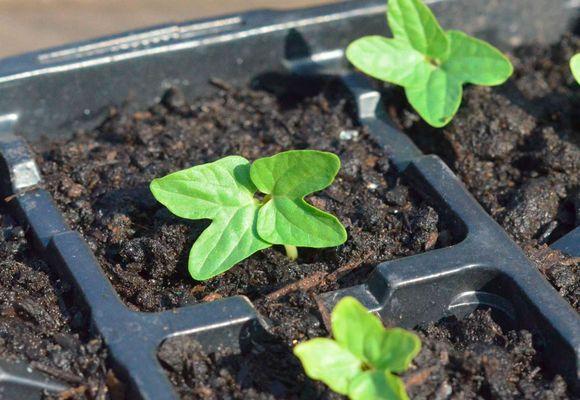
Watering
Water is used at room temperature. Compulsorily defended for more than 48 hours. Before watering, loosening is carried out so that the liquid better penetrates the root system.
Pruning
Trimming and picking is carried out as needed. New pots are immediately prepared for plant transplantation. Watering after procedures is done on the basis of stimulants for rooting, a better healing process.
It is recommended to feed the morning glory at least 2 times every 10 days. Complex fertilizers are chosen for this.

Protection against diseases and pests
Morning glory should be protected from infections early in development. A young plant cannot fight the threat, since it has not yet matured. A black leg is a threat to seedlings.The fault is frequent watering, lack of sufficient heat and light.
You can correct the situation by adjusting the care. Diseased seedlings are subject to liquidation. The remaining healthy sprouts are treated with wood ash, preparations that will not damage the seedlings. A weak solution of manganese will do.

The subtleties of reproduction
Tips on how to grow morning glory can be found in specialized magazines. Experienced gardeners who have long been planting decorative vines on their site are ready to share useful information. Most varieties have similar agronomic requirements. Having successfully grown a single bush, you can gain experience that extends to the next plantings.
The morning glory flower is not too picky about the composition of the earth. The ideal option is black soil or sandy loam, heavy clay soils do not allow the plant to develop normally. A portion of humus or peat can be added to the soil, this will make the soil lighter and more nutritious.

Preparation for planting begins in early April. Ipomoea seeds are sorted, damaged and ugly specimens are discarded, then the prepared material is soaked in a small amount of water for pecking. If the sprouts fail to break through the membrane, it can be gently pierced with a needle.
The containers are filled with soil. A mixture of garden soil with humus and peat is suitable for seedlings. You can also use a purchased universal soil mixture in bags. Seeds are planted with a slight deepening. After sowing, the soil is abundantly sprayed with warm water from a spray bottle. The container is covered with glass or foil and placed in a warm place. Seedlings appear in 10-14 days and begin to develop rapidly. Seedlings need to be watered 2 times a week, using only settled, not too cold water.
Ipomoea can be planted in open ground in mid-May or early June. It all depends on the climatic conditions of the region and the condition of the seedlings. If young plants are too elongated and require support, it is not worth postponing the transfer of seedlings into the ground. If necessary, wooden sticks are installed next to the seedlings to attach the stems. Intertwined vines are difficult to untangle without breaking delicate shoots.
If it is decided to sow flowers directly into the ground, the soil is warmed up by covering it with a thick plastic wrap in advance. Pre-soaked seeds are laid out in the holes, sprinkled with a layer of earth and watered from a watering can with a spray. Do not use a hose; a strong jet of water can wash out the landings. In the first days, the beds should be covered with a film, then they are removed.

Uses of morning glory
Ipomoea is good to shade sunny terraces or verandas, plant them along the mesh fence and close the area from prying, prying eyes. You can simply plant the house on the south side, wrap around the southern windows, and the microclimate in the house will become more favorable - cool and humid, and the boards that surround the house outside will not dry out. On a long-developed area, using a trellis with morning glory, you can separate a garden or vegetable garden, a household plot or a parking lot. And this will be the most beautiful fence.
If you plant a gazebo with a table and benches with morning glories, you get a cozy place to relax. Arches of bent metal rods over the path to the house, entwined with morning glory, will turn this path into a green corridor. It is even easier to build such an arch above the gate at the entrance to the site, to decorate the porch or balcony.
 Morning glory (Ipomoea). Juanedc
Morning glory (Ipomoea). Juanedc
Ipomoea can also be planted in a flower garden. With their help, they break up the flat space of a large flower garden, which makes it more picturesque. Ipomoea can be used to create various green figures or a fountain with jets-stems flying in all directions or directed in one direction. And all that is needed for this is the support of the appropriate form and your imagination.
A very interesting option is to use green and dried trees as supports. Here endless possibilities for creativity open up, up to the creation of works of art.Branches of fruit or forest trees can be attached with wire to pipes driven into the ground, and then wrapped around them with morning glory.
Today there is a huge selection of morning glory seeds. Plants grown from them are characterized not only by the most diverse shape and size of the flower, leaves, but also by the duration and intensity of flowering, the time when the flower opens. You can buy the most unimaginable mixtures of morning glory seeds, resulting in a riot of colors in your garden, in your country house and even on the city balcony.
 Morning glory (Ipomoea). Seán A. O'Hara
Morning glory (Ipomoea). Seán A. O'Hara
Beneficial features
Some parts of the morning glory are used by humans. For example, morning glory pes-caprae has the following uses:
- the juice squeezed from the plant is used in Malaysia to treat fish bites;
- the leaves are used in Indonesia to speed up the healing of boils;
- juice from young leaves is boiled in coconut oil and used to treat ulcers, and the seeds, along with areca nuts, are taken for abdominal pain and cramps;
- in the Philippines, boiled leaves are used to treat rheumatism.
Scientists are beginning to consider sweet potatoes (I. batatas) not only as a source of food.
The study was conducted to determine the growth of bacteria that can be inhibited by cultured sweet potato leaves.


The results of this experiment led the researchers to conclude that sweet potato leaves definitely contain antibacterial compounds that are resistant to E. coli. In addition, the growth rate of saphylococcus aureus (the type of bacteria responsible for staphylococcal infections) was also significantly reduced by chemical compounds found in sweet potato leaves.
Consequently, these leaves have a promising future, preventing the growth of bacteria that cause food poisoning from certain foods and may even help with certain skin infections.
Growing morning glory in pots is quite possible. They are even good for decorating a terrace or balcony. For this:
- choose a pot that is wide enough, about 30 cm in size;
- make sure there are holes in the bottom of the pot and place a layer of clay pebbles on the bottom;
- fill the pot with a mixture of soil for flowering plants;
- water without flooding the plant.
More details about the features of growing - below.































